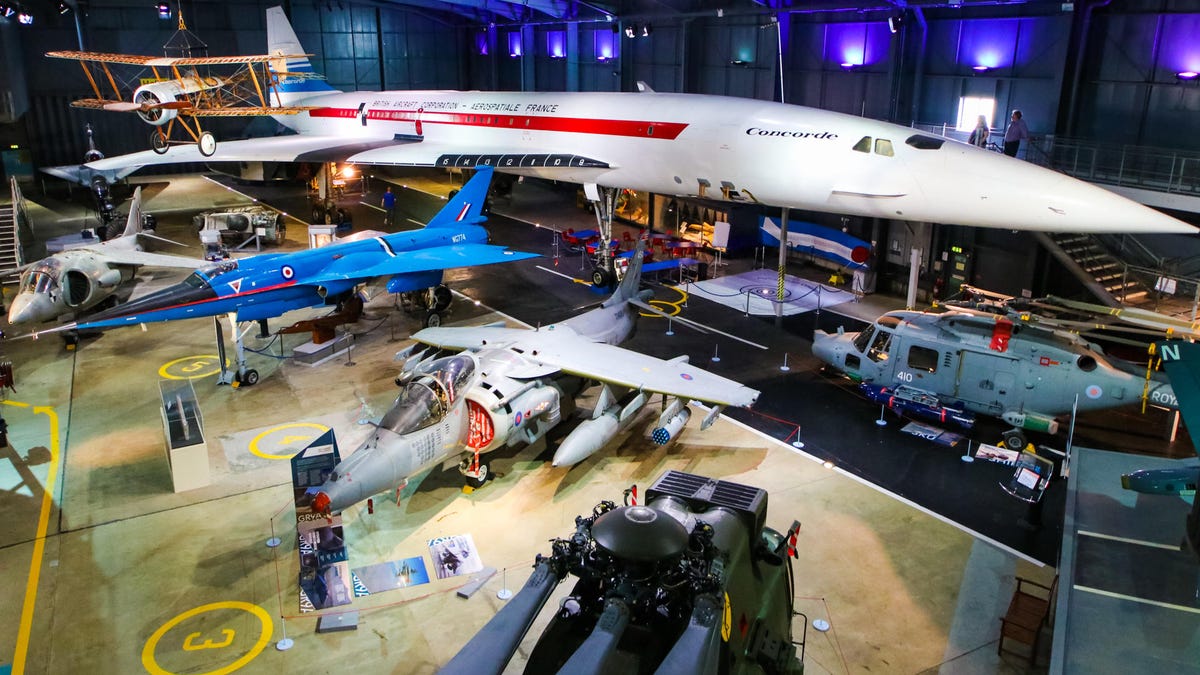 Why You Can Trust CNET
Why You Can Trust CNET Britain’s Fleet Air Arm Museum is an awesome show of sea air power
Celebrating over 100 years of naval air power, the stunning museum has loads of biplanes, iconic jets and legendary supersonic aircraft. Here's the full tour

The rotors of a helicopter thump menacingly overhead, the first hint this is no ordinary museum. Signs and fences are telltale indications of a military presence, and indeed, Royal Naval Air Station Yeovilton is an active military base. It's operated by the Fleet Air Arm, one of the five branches of the UK's Royal Navy.
The base is a fitting spot, then, for the Fleet Air Arm Museum, home to over 100 years of aviation history, predominantly naval aviation. Biplanes and helicopters, jets and propellers, most with the cool foldable wings so common to carrier-based aircraft.
But that's not all. There's also a prototype Concorde, and the proto-proto Concordes, the Handley Page HP.115 and BAC 221 that were used to help design the last supersonic airliner's iconic wings. And since the land-locked Yeovilton airbase isn't exactly conducive to exhibiting an aircraft carrier, one of the halls is mocked up to represent one, complete with wall-sized videos of launches and recoveries, and even what the inside of the HMS Arc Royal looked like in the 1970s.
Here's a look around this excellent museum.
Air power at sea
It didn't take long after the invention of the airplane for someone to figure out they'd be a handy thing to have on ships at sea. From ship-spotting to fleet defense, and eventually sea and land attack, air power became a vital part of every major navy.
Britain's Fleet Air Arm was founded in 1914 as the Royal Naval Air Service, and has participated in every major conflict since, including the Falklands, both Iraq wars and even in Afghanistan, hundreds of miles from the nearest ocean.
Founded in 1964, the Fleet Air Arm Museum has four halls full of aircraft, each focusing on a different aspect of the FAA's history. As an American, seeing "FAA" written everywhere continually made me think of our FAA. I wonder if Brits get that too when seeing ours written.
Hall 1 has several early aircraft, biplanes from the earliest days of naval flight. Hall 2 has many far more recognizable aircraft from WWII, like a Supermarine Seafire and Grumman Martlet. There's also a viewing area here where you can see the apron and runway of RNAS Yeovilton. During my visit several Royal Navy AgustaWestland Wildcats were practicing takeoffs, hovering and more.
The Fleet Air Arm Museum's Aircraft Carrier Experience, a recreation of a 1970's HMS Ark Royal.
Hall 3 is a recreation of the HMS Ark Royal, an aircraft carrier with a long history. The floor is done up like the flight deck, the end walls show the carrier launches and recoveries. One long wall has a view like you're at sea, while the other is a the "island" of the ship. Or at least, a recreation of such. Inside rooms represent key parts of the Ark Royal, with video screens offering information and a glimpse of what it was like to live and serve on board.
The last hall departs somewhat from the rest. While different versions of the famous Harrier "Jump Jet" are here, the big (literally) exhibit is the prototype British Concorde. This was the second Concorde to fly, and the first built in Britain. You can walk through end-to-end, checking out all the heavy test equipment, a mock-up of what the seats looked like in the production version, and even stick your head in the cockpit.
Landing to the west
The Fleet Air Arm Museum is smaller than the big RAF museums in London and Cosford, but it is by no means small. However, it is a bit harder to get to. While those museums you could do in a day trip from London, the FAA Museum is about an hour by car south of Bristol, or about three hours by bus from London, in "the West Country." It's a lovely area, though, and if you have time leftover from visiting the lovely seaside towns, there's also the Helicopter Museum and the Morgan Factory, both of which we've toured and are great fun.
As well as covering audio and display tech, Geoff does photo tours of cool museums and locations around the world, including nuclear submarines, aircraft carriers, medieval castles, epic 10,000-mile road trips and more.
Also check out Budget Travel for Dummies, his travel book, and his bestselling sci-fi novel about city-size submarines. You can follow him on Instagram and YouTube.

